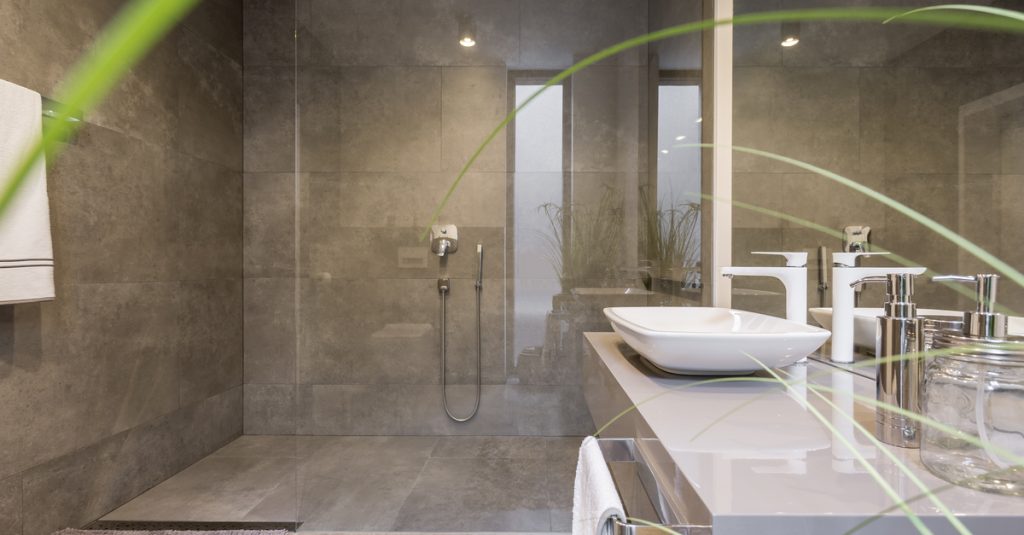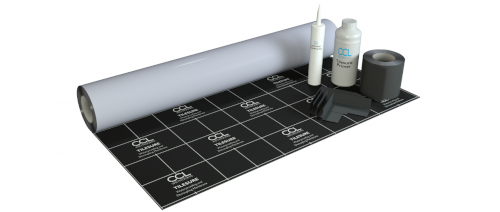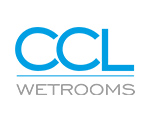When it comes to tanking a wetroom floor, there are two schools of thought about the waterproofing products you should use. Do you opt for a liquid membrane or a sheet membrane? Due to the humid conditions of a wetroom, the waterproofing membrane needs to be able to cope with fluctuations in temperature, as well as the gentle movement across the wetroom that occurs as a property expands and contracts over time. The wetroom floor is particularly susceptible to slight movement between the tiles and the substrate throughout its lifetime.

Whilst both types of membranes have their benefits, CCL Wetrooms recommend the installation of a sheet membrane to the floors and floor/wall junctions in your wetroom which will ensure a robust tanking solution to the area’s most at risk from leaks. Installing a waterproof sheet membrane with de-coupling properties underneath floor tiles can improve your floors flexibility and will help prevent any cracks and avoid tensions.
Sheet Membranes vs Liquid Membranes
A better seal
The most important requirement of a membrane is that it provides a 100% seal. Even the tiniest gap can completely compromise a wetroom, as water will inevitably find the gap and cause leaks. As the wetroom floor is the area most susceptible to water pooling and leaks, it requires the most robust waterproofing solution.
Sheet membrane has the advantage over liquid membrane of making it very easy to see where the membrane is. When you’re painting a liquid membrane, you can inadvertently create gaps in the seal while sheet membrane can be cut exactly to size.
Increased productivity
In addition, sheet membranes have the advantage of a protective backing on both sides that will allow you to keep working in the space even while the membrane is bonding to the substrate. When you’re installing wetrooms on large, commercial projects, productivity is essential. You need everyone working as efficiently as possible. In addition, the backing paper ensures that the membrane remains dust free throughout the installation process.
The problem with liquid membranes is that they can take up to 24 hours to dry depending on the room temperature. During this time, the wetroom space can’t be accessed without compromising the seal. This means that electricians, tilers or other workers can’t carry out their work while the membrane is drying.
Sound proofing
Unlike other waterproofing systems, sheet membranes such as Tilesure, act as an acoustic barrier, improving the sound impact insulation properties of a wet room by 11db. This is particularly beneficial in properties such as flats and apartment blocks, where the membrane will help reduce sound travelling through to the floors below.
Ready to tile immediately
Thanks to the design of a sheet membrane, the wetroom is ready to tile as soon as the membrane is installed, unlike liquid membranes. This makes it ideal for fast track construction on large projects.
Factory-controlled thickness
Whether you’re installing onto concrete or timber floors, the thickness of the waterproofing membrane needs to be consistent to ensure it provides a fully waterproof base prior to tiling. Applying a liquid membrane rather than a sheet membrane can often result in an uneven layer and determining the thickness can be time consuming. Sheet membrane has uniform thickness, giving you total peace of mind that applied correctly it will be watertight.
Liquid Membrane for waterproofing the walls
The walls of a wetroom do not require such a robust waterproofing solution and a liquid membrane such as our Flexible Wall Membrane is ideal. A 1mm liquid coating will provide a waterproof barrier and allow for the walls to be tiled after application. A liquid membrane on the walls also has higher weight bearing properties than a sheet membrane.
A Comprehensive Waterproofing Approach for Peace of Mind
CCL Wetrooms recommend Tilesure, a self-adhesive waterproof sheet membrane that is used prior to the application of ceramic tiles and natural stone onto timber and solid floors in wetrooms. The self-adhesive waterproof membrane consists of a thick rubberised waterproof layer incorporating a woven glass fibre mesh on one side and is applied at room temperature. The floors should be waterproofed to at least one metre beyond the shower area in all directions to ensure that water spray is fully contained. Splash from a standard shower head can reach as far as this and an open plan wetroom without a glass screen or half height wall will do little to contain the water. Therefore, it is important that the floor is waterproofed beyond the shower area to prevent water escaping into the bathroom.

Waterproofing is an area that must never be compromised in a wetroom. At CCL Wetrooms, we believe that a comprehensive tanking solution will ensure a watertight wetroom for the life of the tiles. For that reason, we advise using a sheet membrane to tank the wetroom floor and a liquid membrane on the wetroom walls. Reinforcing tape should also be used on all wall and wall/floor junctions as well as corners and soap recesses.
As one of the UK’s leading wetroom specialists, we offer an unrivalled range of innovative products designed to create stylish contemporary wetrooms. All of our products, including our sheet membranes, are backed up by our unique lifetime guarantee. For more information, contact us today.









